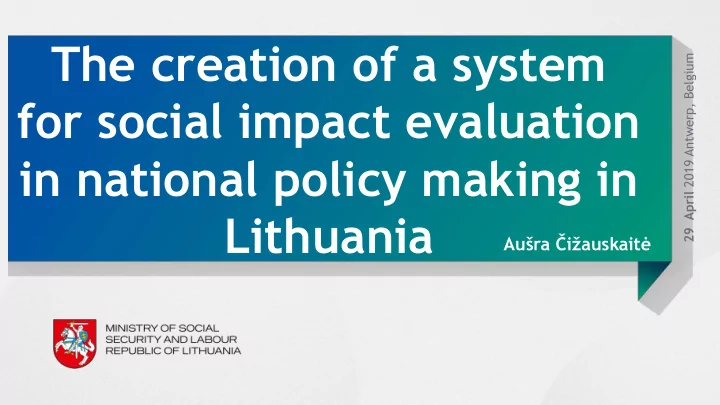

The creation of a system 29 April 2019 Antwerp, Belgium for social impact evaluation in national policy making in Lithuania Aušra Čižauskaitė
THE NEED FOR A SYSTEM Tax and social insurance contribution reform Increased amount of State Supported Income; Introduction of disregarded income, universal child benefit; Changes in unemployment social insurance; Etc. European Commission: “ What impact on poverty rate reduction and income inequality does Lithuania expect from the recent increase in adequacy of the social safety net (minimum income benefits; unemployment social insurance benefits; pensions)? “ But...No tool to evaluate ex-ante social impact
PROJECT OVERVIEW The project is aimed to develop a system that would help to optimize Ministry's forecasting, decision-making and other related processes and would help to adopt decisions related with the Ministry's areas of activity. During this project, models conforming modern realities are being developed as well as methodologies describing them. Started in January 2018; A team of 6 members;
THE SOCIAL IMPACT EVALUATION: GOALS EUROMOD tax-benefit model use in the Ministry Disaggregated variables Hypothetical household tool for Lithuania Administrative data /Calibrated database Web-interface for public society
ADAPTING HHoT ADD-ON FOR LITHUANIA Add-on for families with children Household types 2016 2017 2.3 2.6 1 adult 1 child 1.5 1.6 1 adult 2 children 9.5 11.2 2 adults 1 child 11.8 10.5 2 adults 2 children 2.5 2.3 2 adults 3 children 1.7 1.4 2 adults 1 student 17.6 17.7 1 adult 0 children 23.4 23.6 2 adults 0 children
APPLICATION OF CALIBRATION ON MICRO DATA (1) o The Minisry‘s goal - representative ex-ante analysis. o EU-SILC data lag o Rapid employment and demographic changes in Lithuania EUROMOD database LT_2017_a1 Based on UDB_v10-1 Year of collection 2017 Period of collection May-June 2017 Income reference period 2016 Sampling Stratified random sampling Unit of assessment Household and individual Coverage Private households 11127 individuals, 4 944 households Sample size Response rate 73.57 %
APPLICATION OF CALIBRATION ON MICRO DATA (2) NUMBER OF UNEMPLOYED PERSONS (THOUS.), 2009 2009-2018 300 250 200 150 100 50 0 2009 2010 2011 2012 2013 2014 2015 2016 2017 2018
APPLICATION OF CALIBRATION ON MICRO DATA (3) RESIDENT POPULATION AT THE BEGINNING OF OF THE YEAR, 2009-2019 3300000 3200000 3100000 3000000 2900000 2800000 2700000 2600000 2500000 2009 2010 2011 2012 2013 2014 2015 2016 2017 2018 2019
APPLICATION OF CALIBRATION ON MICRO DATA (4) Re-weigthing used by Lefebure et al. (2007) Brewer at al. (2009), Kump and Navicke, 2014): CONTROL VARIABLES: o Age structure (Eurostat) o Sex structure (Eurostat) o Unemployment rates (LFS data of 2015) o Level of urbanization (Statistics Lithuania) o Household composition* (Eurostat) o Bounded linear and logistic method , suggested by Deville and Särndal (1992) o Calibration at the household level, using integrative calibration in all cases when controls are at individual level.
LINEAR AND LOGISTIC PROCEDURES PRODUCE SIMILAR RESULTS (5) Logistic method was chosen in order to avoid negative values
KERNEL DENSITY ESTIMATE (6)
EXIT AND ENTRY WEIGHTS (7)
DIFFERENCE (8)
AT-RISK-OF-POVERTY AND INEQUALITY RATES 2017orig 2017cal 2018orig 2018cal 2019orig 2019cal 60% median HDI Total 21.98 21.67 20.40 19.63 20.44 19.66 60% median HDI 0-15 years 23.41 23.25 19.17 17.95 18.91 17.69 16-24 years 26.44 25.36 24.73 23.02 24.65 22.62 25-49 years 15.93 15.54 14.42 13.58 14.27 13.36 50-64 years 18.63 18.29 17.90 17.41 18.08 17.61 65+ years 32.17 32.33 31.74 31.59 32.30 32.28 Gini 35.98 35.82 34.90 34.63 36.77 36.61 S80/S20 6.73 6.64 6.12 6.00 6.52 6.39
QUESTIONS AND THINGS TO CONSIDER 1. HYPOTHETICAL HOUSEHOLDS IN LITHUANIA: Optimal number of household with children Hypothetical households characteristics Indicators using hypothetical households: methodology 2. DATA CALIBRATION: Methodological advice Control variables 3. OTHER
Recommend
More recommend